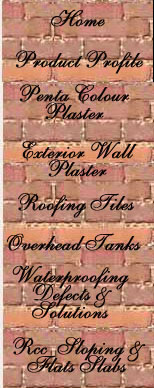| CONVENTIONAL |
DEFECTS
WITH REASONS |
| Plaster
is applied on masonary soaked with water and cement slurry.
This gives a mediocre adhesion. |
Wet
masonry shrinks on drying much more than plaster resulting
in bulges of the plaster in which air gaps are formed. This
gets heated in the sun and expands pushing the plaster outwards
causing it to crack. Rain water leaks through these cracks
showing up as damp patches on the inside. |
| Fresh
RCC surface is made rough by hacking with a hammer. |
The
vibration caused by hammering on green RCC disturbs the aggregate
and the steel bars making tiny voids. This reduces its strength
and life. |
| Cement
slurry is thrown on the masonry before plastering. |
As this
slurry is thrown at random (not applied over the whole surface)
the grip of the plaster to the masonry is not uniform. |
| Mortar
is thrown with a towel. |
Throwing
mortar traps air inside the plaster, resulting in plaster
of low density. |
| Water
added is approximate. |
Excess
water runs off causing sagging of the plaster, less water
traps air. |
| If mortar
has correct water. |
Some
water runs off drying the plaster, this interferes with the
initial setting which is crucial for cement. |
| Plaster
is sponged. |
Sponging
wet plaster removes surface cement, this weakens the top plaster. |
| Holes
are made in the masonry for supporting scaffolding. |
These
holes are filled with mortar while finishing the plaster.
This mortar settles leaving an empty space above, also outside
uniformity is lost. |
| Between
beam bottom and top of masonry. |
The
bonding between these two is not complete, as filing is done
only from the sides, the center remains empty, and cracks
appear on the adjoining surface. |
| REMEDIES |
HOW
PENTA COLOR PLASTER WORKS |
| Plaster
is applied to dry masonry. |
Very
high adhesion is obtained by applying primer and bridge technique. |
| Concrete
surface is cleaned & roughened mechanically. |
High
adhesion on concrete is achieved by the above technique. |
| Cement
slurry is not used. |
A primer
is sprayed evenly over the entire surface, to obtain uniform
grip. |
| Mortar
is not thrown. |
Mortar
is applied with a spray gun, hence extremely compact. |
| The
mortar is mixed in correct proportion only. |
Mortar
with correct water and plasticizer retains water for curing,
the plaster does not sag, contains no air bubbles, making
it extremely dense. |
| Correct
mortar mixed with plasticizer. |
This
mortar has enough water in the plaster for complete curing.
Only loss of surface water due to evaporation needs to be
made up. |
| Sponging
is not done. |
A spray
with a pneumatic fun makes a rough sandy finish, so hotels
are filled at the start of plaster resulting in a uniform
perfect finish. |
| Holes
in masonry are filled before commencement of plaster. |
Our
metal scaffolding does not need mid way suppports, so holes
are filled at the start of plaster resulting in a uniform
perfect finish. |
| All
spaces below the beams are filled. |
These
and all other hollow spaces in masonry are filled by pneumatic
injection of cement slurry with an additive after the third
layer. |


